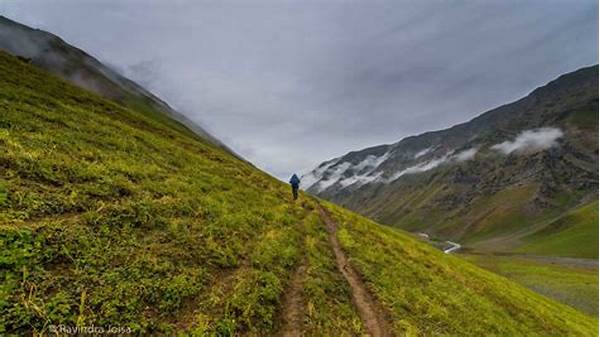Hey there, fellow photography enthusiasts! Today, we’re diving into a fascinating aspect of capturing the wonders of the natural world: leading lines in nature photography. You know, those magical lines that guide the viewer’s eye through an image, creating a path that adds depth, interest, and a sense of direction! Whether you’re an amateur snapping shots with your smartphone or a seasoned pro with a DSLR, understanding how to use leading lines can seriously kick up your photo game. So grab your camera, and let’s explore some creative ways to incorporate this technique into your nature shots.
Read Now : Transparent Digital Watermark Techniques
The Magic of Leading Lines in Nature Photography
When we talk about leading lines in nature photography, we’re essentially discussing the art of shaping the viewer’s experience. Imagine a winding trail through a lush forest or a meandering river cutting across a valley; these are all examples of natural leading lines. By capturing these elements, we’re inviting viewers to embark on a visual journey within our photos.
Leading lines serve not only to direct attention but also to infuse your photos with a sense of scale and distance. They can create layers in your composition and distinguish between the foreground, middle ground, and background seamlessly. When done right, leading lines in nature photography transform a static image into a dynamic one, full of life and possibility. So, next time you venture out, be on the lookout for those lines in the landscape. They’re a powerful tool waiting to elevate your artistry to new heights.
But where do you begin? Start by scanning your environment. Look for lines in the terrain: the edges of a coastline, the arch of a mountain range, the alignment of trees. Try composing your shot so these lines lead towards an interesting focal point—perhaps a sunset, an animal, or a distant peak. Experimentation is key, so don’t be afraid to try different angles and perspectives. Quite often, some of the most breathtaking shots come from the most unexpected places.
Natural Examples of Leading Lines in Nature Photography
1. Forest Trails: Imagine walking through a dense forest. The trail you’re on naturally forms leading lines in nature photography, guiding the viewer deep into the frame.
2. Rivers and Streams: Watercourses are fantastic for creating fluid leading lines, inviting the eye to flow from one end of the frame to the other.
3. Mountain Ridges: The undulating ridges of mountains make for dramatic leading lines, drawing attention to the grandeur of the scenery.
4. Beach Shorelines: The meeting point between sand and surf offers a perfect natural line, leading the viewer along the coastline’s edge.
5. Desert Dunes: The rolling curves of sand dunes form striking leading lines in nature photography, creating a sense of movement and rhythm in the still image.
Techniques for Capturing Leading Lines in Nature Photography
Understanding leading lines in nature photography is all about experimentation and observation. Before pressing that shutter, take a moment to visualize how the lines in your scene interact. Are they pulling the viewer’s eye where you want it to go? The beauty of nature lies in its unpredictability; use this to your advantage.
First, consider the angle from which you’re shooting. A low angle shot can accentuate the lines and add an imposing feel to the scene, while an overhead shot might give a more comprehensive view of the intermingling natural lines. Also, remember that lines don’t need to be straight. Curved or spiral lines can add a dynamic touch and enhance the sense of depth.
Another pro tip is to use leading lines in conjunction with other compositional techniques. For instance, employing the rule of thirds can help reinforce the impact of your leading lines, further drawing viewers into the heart of the image’s story. And honestly, don’t shy away from breaking the “rules” now and then—some of the most captivating photos come from bending traditional guidelines creatively.
The Impact of Leading Lines in Nature Photography
Leading lines in nature photography aren’t just about creating pretty pictures; they have a profound impact on how images are perceived. Here are a few reasons why they’re a big deal:
1. Guidance: They inherently guide the viewer’s gaze through the composition, providing a visual journey.
2. Depth: By directing the eye from the foreground to the background, lines can add a three-dimensional feel to a photo.
3. Focus: They can lead the viewer towards a specific focal point, enhancing the significance of the subject.
4. Rhythm: Lines can create a sense of rhythm and movement, making even a static image feel dynamic.
Read Now : User-friendly Watermarking Tutorials
5. Balance: Properly balanced lines can bring harmony and order to the chaos of nature scenes.
6. Interest: Leading lines introduce complexity and storytelling elements, keeping the viewer’s attention longer.
7. Creativity: They encourage photographers to explore unconventional angles and perspectives.
8. Emotion: Lines can evoke emotion, whether it’s the tranquility of a gentle stream or the ruggedness of mountain peaks.
9. Connection: They can link different elements within a photo, creating a cohesive composition.
10. Theme: Finally, lines can emphasize themes like journeys, isolation, or infinity, depending on how they’re used.
Composition Tips for Leading Lines in Nature Photography
When you’re out capturing leading lines in nature photography, consider these composition tips to enhance your images. First, always look for natural contrasts or colors that complement the lines. This can help accentuate them, making them the star of your shot. In addition, incorporating a human element in the image, such as a lone hiker on a trail, can add a sense of scale and resonate emotionally with viewers.
Don’t forget about lighting—natural light is crucial in defining and highlighting your lines. Early morning or late afternoon, when the sun is low, often results in longer shadows and richer contrasts that emphasize the leading lines in nature photography. These golden hours can transform a mundane scene into something magical.
Lastly, practice patience and persistence. The perfect leading line shot often requires waiting for the right moment or returning to the same spot under different conditions. This kind of dedication will help you discover unique and inspiring compositions that you might have overlooked on a quick first glance. And always, keep challenging yourself.
Slang Tips for Leading Lines in Nature Photography
Alright, peeps, let’s get down to the good stuff! Diving into the world of leading lines in nature photography, we’re talkin’ about those sweet compositional tricks that’ll have your snaps looking mighty fresh. First off, always stay woke to your surroundings—lines are everywhere, like, literally.
Think about those tight trails you wander down or the way a river just snakes through a scene. That’s your golden ticket, dude. Snap those curves and create a visual story that’ll make your Insta followers go wild!
Lighting’s a game-changer, too. Aim for that lit golden hour; its magic light is no joke. Trust me, when the shadows play just right, your leading lines become the star of the show. So pack patience and maybe a snack, ‘cause good things come to those who wait.
A Summary of Leading Lines in Nature Photography
To wrap things up, leading lines in nature photography are more than just a neat trick—they’re a transformative tool in your composition arsenal. By guiding viewers through your images with the natural lines found in landscapes, you’re doing more than clicking a shutter; you’re telling a visual story. These lines can draw attention, add depth, and imbue your photographs with emotion and narrative, keeping eyes glued to your work for longer.
Next time you’re out exploring the great outdoors with your camera, remember to stay keenly aware of your surroundings. Nature’s got all the lines you need, you just gotta find them! Whether it’s a tranquil beach, a bustling forest trail, or a mighty mountain, each scene holds the potential for creative expression. Experiment, have fun, and embrace the unexpected. Capturing the perfect shot isn’t just about skill, but about having an adventurous spirit and an open eye for the wonders nature has to offer.



